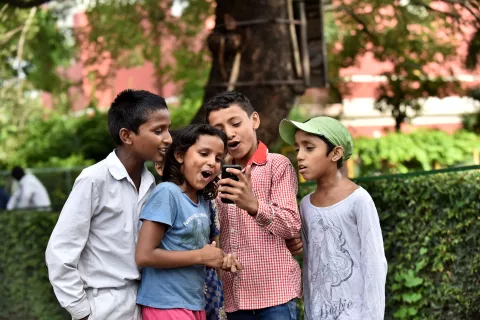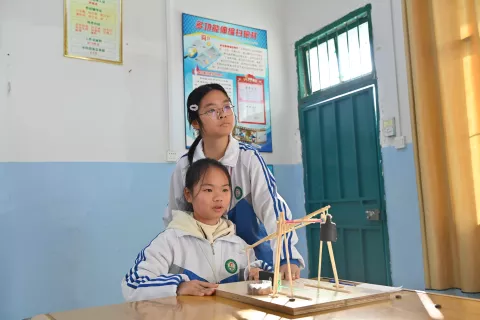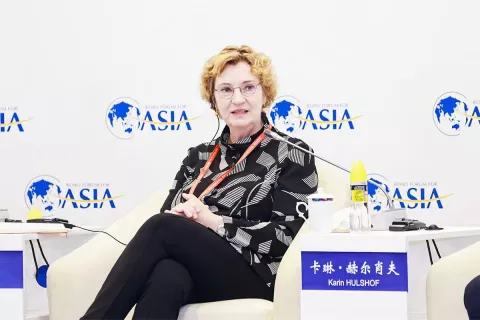Bridging the Digital Divide
Bridging the Digital Divide
She never thought the countryside scene could be so interesting.
“The ancient farmers' houses of these Zhuang minority groups have three floors – the first is for raising animals like pigs and hens, the second is for people and the third is for storing grain and corn.
“It's a pretty smart design because it saves space and is very environmentally-friendly,” says 11-year-old Tang Zijun, fifth-grader at Haizhuzhonglu Elementary School in Guangzhou, capital of Guangdong Province with a population of 10 million.
Tang is talking about the PowerPoint photos she just received from Tong Jingyan, a student of Jingxi Pilot Elementary School of Guangxi Zhuang Autonomous Region,688 kilometers away to Guangzhou's west.
In the county town of Jingxi, where 99 percent of the population of 580,000 is Zhuang minority, Tong is studying photos of ancient Guangdong farmhouses taken on Zijun's recent school field trip.
“The ceiling is so high to handle the mild weather, plus there are three doors to ensure safety,” says the 11-year-old boy. “I think it must be very comfortable indoors – cool in summer and warm in winter. No need for an air-conditioner.”
This exchange forms just one small link in a United Nations Children's Fund (UNICEF) distance education project launched last year involving 15 poor Guangxi and Chongqing primary schools and seven prosperous Guangdong, Shanghai and Anhui Province schools. Students were divided into groups to conduct research on the same topic, exchange ideas and discuss their findings in a chat room at the project website.
Guangxi and Guangdong students took weekend field trips to photograph rural homes, interview local residents and then search for more information about them on the Internet. Finally with their teachers' help, the students assembled a PowerPoint presentation to show their online friends.
The housing project gave Tong Jingyan a new outlook on history.
“I think our forefathers were in a way more intelligent than today's people at coping with the environment.
“I feel like an expert searching for treasure that is invisible to others, or,” – his eyebrows raise – “as if I were entering a magic tunnel that converts time.”
Time travel and treasure-hunting aren't the only online activities.
“She (Tang) taught me how to use QICQ [an instant messaging program], and how to find information through online search engines like Baidu or Sina. It's so convenient,” says Tong.
He has picked up a handy tip from his online pal. “I now know how to play online electronic games,” he giggles. “I need to practice regularly to improve my skills, but teachers don't allow us to play.”
The pictures of skyscrapers also excited the Zhuang boy, who has never been to a big city.
“They're like rockets on top of the road. I think my head will hit the back of my shoulders if I try to see the top of one. If I were there, I think I might fall over…” He then demonstrates his point with gusto.
Besides exchanging information on their homes, students from different schools worked together online creating their own designs.
Zhang Jing of Xinjing Centre Elementary School in Guangxi drew a face for the logo of the distance education programme. His friends at Luying Elementary School in eastern Anhui Province didn't seem satisfied.
“We discussed it online and finally decided to change the eyes of the child into two computer mice to address the importance of the computer in our life,” explains the fifth-grader.
Then they came up with a slogan: Hand in hand for a better world.
“A better world, in my opinion, is a world with no war and no hunting of animals,” says Zhang.
“Animals are rather unfortunate. So we should help not only children in war-stricken areas but also those beautiful creatures. They shouldn't be made into fur coats or delicious meals.”
Such fresh ideas surprised even Annette Nyquist, a UNICEF distance education project official. “It's not that important how marvelously they master these information technology skills,” she says. “It's an active learning attitude and a sense of cooperation that really counts.”
The project is a cooperative venture between UNICEF and the National Centre for Educational Technology (NCET). With US$ 230,000 funding from US CitiGroup, the hope is that it will reduce the great digital divide between eastern and western China.
The number of Chinese with Internet access rose to 111 million at the end of 2005, with 64.3 million having broadband access, according to figures released from China Internet Network Information Centre (CNNIC) in January 2006.
But the 19.3 million netizens who live in rural areas represent only 2.6 percent of the rural population, while the 91.7 million netizens in cities are nearly 17 percent of the urban population. China's eastern coastal areas account for 57.8 percent of all of China's netizens.
“With the steady torrent of impressive statistics coming out of China's information technology sector in recent years, it's easy to forget about those who have been left behind and whose lives remain largely untouched by the information revolution,” says Li He, an NCET official in charge of the project.
“So distance education in a way reaches people in circumstances in which they would otherwise be deprived of opportunities to learn.”
Xinjing Center Elementary School in Guangxi is very different from its sister in Guangdong. The 99-year-old school of 1,509 students has one room that opened in 2002 with 40 computers, only half of them online.
“When we have online discussions with them (students in Guangxi), they told us that a group of five students share one computer to chat with us,” says 11-year-old Lao Shanyi from Haizhuzhonglu Elementary School in Guangzhou.
“But for us, everybody has his or her own computer. I think we're really lucky.”
The 672 students of Guangzhou Haizhuzhonglu Elementary School are indeed lucky: They have 130 computers in three computer rooms, established in 1996. Each computer room has around-the-clock Internet access. Three students here even won national computer operating awards in 2004.
Lao Shanyi's teacher, Hu Xinghua, sees real benefit for both sides from the exchange.
“Students learn to share information together and seek answers to questions actively instead of waiting for teachers to feed them,” she says.
Nyquist notes that the project is designed to put students in the center of their own learning. “This online practice plays an important role in transforming teacher-centred instruction into child-centred instruction to finally improve education quality,” she says.
“Plus,” says Hu, “these urban kids come to realize that some children of their age in the west are deprived of the resources that they often take for granted.”
Says Lao Shanyi, “Sometimes we posted questions in the chat room to our Guangxi sister school students. But several weeks passed with no answer from them.
“We were very disappointed and frustrated, thinking that they might not want to make friends with us,” she says.
“Later I learned that the Internet conditions there are rather poor, and it is difficult for them to get online as regularly as we do.”
This gulf is very much on the mind of the Chinese government. By the end of 2003, at least 10,000 primary and middle schools in the poor western provinces had been equipped with primitive computing facilities or internet access.
UNICEF's distance education project includes 180 schools in 18 counties of 12 provinces in China. The UNICEF-NCET project plans to expand from 15 to 50 schools in 2006, adding Sichuan Provinces and more counties from Guangxi Zhuang Autonomous Region. In addition, more schools in the eastern cities will be chosen to take part in the project as partner schools.
Distance education is about more than just the media, notes Nyquist.
“Technology is only a means, not an end itself,” she says. “It's just like a pair of new shoes for a better walk on the road. With the 'shoes' of distance education, students, hopefully, can walk more smoothly on the road to quality education and finally to explore life on their own.”
Technology on its own does not guarantee joy and enlightenment, according to Wang Fengji of Jingxi Pilot Elementary School.
“In the old days when there was no television at home, my family would sit together and chat to each other as night fell.
“But nowadays, everybody is glued to the television, ignoring the existence of others. I feel lonelier than before.”
Tong Jingyan says he prefers reality to virtual reality.
“What I yearn for most is not to sit all day long in front of a computer,” he says. “What really attracts me is going fishing or making bamboo-flavoured rice outside in the fields with my friends or doing field research with my classmates and teachers.
“I want to know the secret of nature and things around us. It's amazing, isn't it?”





